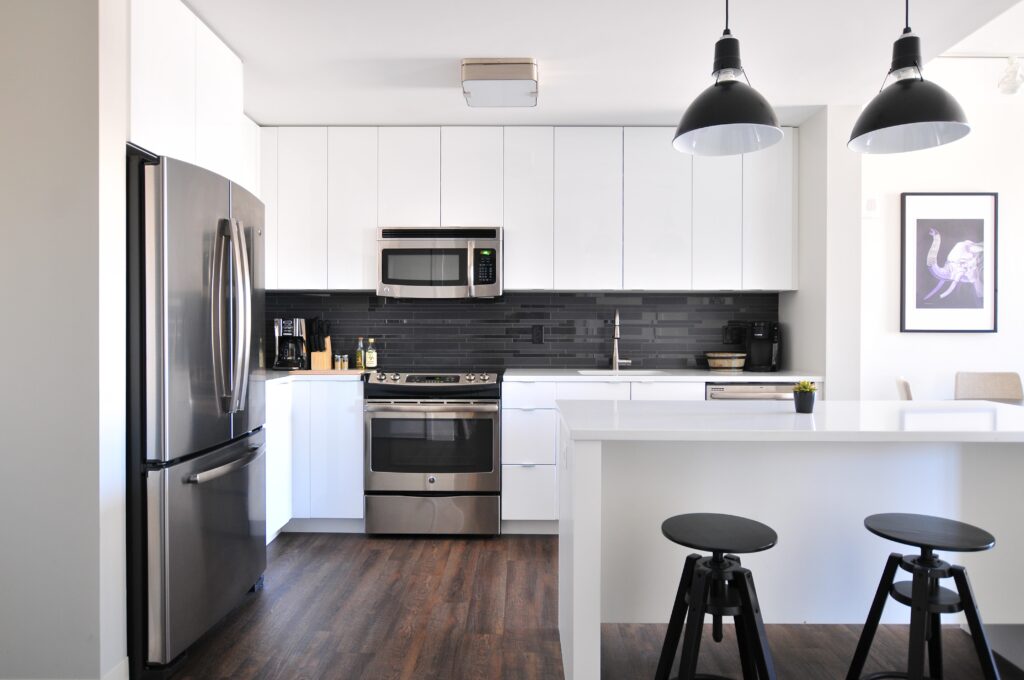Imagine living in a cozy shipping container home, nestled in a picturesque location, with all the conveniences of modern living. Now, picture adding a garage to this unique dwelling to further enhance its functionality and appeal. But how can you achieve this seamlessly? In this article, we will explore the best ways to incorporate a garage into a shipping container home, ensuring that it not only complements the existing structure but also provides an ideal space for parking, storage, and perhaps even a workshop. Whether you’re a DIY enthusiast or planning to hire professionals, we’ve got you covered with innovative ideas and practical tips to make your shipping container home truly stand out.



This image is property of images.unsplash.com.
Understanding The Basics of Shipping Container Homes
Shipping container architecture is a growing trend that involves using repurposed shipping containers as the primary building material for homes. These containers, typically made of durable steel, are originally designed for transporting goods across long distances. However, their versatility has led to a creative solution for affordable and sustainable housing.
Concept of shipping container architecture
The concept of using shipping containers as building blocks for homes dates back to the 1980s. Architectural and engineering advancements have made it possible to stack and modify these containers to create functional and comfortable living spaces. The popularity of shipping container homes has increased in recent years due to their eco-friendly nature, cost-effectiveness, and unique aesthetic appeal.
Benefits and challenges of shipping container living
Shipping container homes offer numerous benefits. First and foremost, they are much more affordable compared to traditional brick-and-mortar houses. The cost of purchasing and modifying a shipping container is significantly lower than building a conventional home from scratch. Additionally, shipping container homes have a smaller carbon footprint as they repurpose existing materials. They also provide a quick and efficient construction process, making them an attractive option for those looking for a time-efficient solution.
However, there are some challenges to consider when it comes to shipping container living. The limited size of individual containers may require multiple containers to be joined together to create a spacious home. Insulating these containers can also be a challenge, as the steel walls conduct heat and cold and may require additional insulation for comfort. Additionally, permits and regulations may vary depending on the location, so it’s important to familiarize yourself with local building codes before embarking on a shipping container home project.
Planning Your Shipping Container Garage
If you already have a shipping container home or are planning to build one, adding a garage can provide valuable storage space for vehicles, tools, and other belongings. Proper planning is essential to ensure the garage meets your needs and seamlessly integrates with your existing home.
Determining the purpose of the garage
Before starting the planning process, consider the primary purpose of your garage. Will it primarily be used for vehicle storage, or will you also need space for a workshop or additional storage? Understanding your specific requirements will help determine the size and configuration of the garage.
Choosing the location for the garage
The next step is to select the location for your shipping container garage. Consider factors such as convenience, accessibility, and how it will fit in with the overall design of your property. It’s important to ensure that the selected area can accommodate the size of the garage and meets any local zoning regulations.
Space requirements and dimensions
Once you have determined the purpose and location of the garage, it’s time to calculate the required space and dimensions. Consider the size of your vehicles and any additional storage or work areas you may need. This will help you determine how many containers you will need and how they should be configured to provide the desired space.



This image is property of images.unsplash.com.
Choosing The Right Shipping Container For Your Garage
Choosing the right shipping container is crucial to ensure a successful garage construction project. Consider the following factors when making your decision:
Standard dimensions of shipping containers
Shipping containers come in various standard sizes, the most common being 20 feet and 40 feet in length. The width is usually around 8 feet, and the height is typically 8.5 feet. These dimensions will help you determine how many containers you will need and how they will be arranged in your garage.
New vs used shipping containers
When selecting a shipping container for your garage, you have the option to choose between new and used containers. New containers offer a pristine condition and are free from any wear and tear. However, they can be more expensive. Used containers, on the other hand, can be more budget-friendly but may require additional repairs and modifications.
Important features to look for
Apart from the standard dimensions, there are other important features to consider when choosing a shipping container for your garage. Look for containers with sturdy flooring, minimal rust or structural damage, and secure and functioning doors. Thoroughly inspect the containers before purchasing to ensure they meet your requirements.
Design Considerations for Shipping Container Garages
Designing your shipping container garage involves finding the right balance between functionality and aesthetics. Consider the following aspects when planning the design:
Choosing a design that matches your home
To create a cohesive look, choose a design for your garage that complements the style of your existing shipping container home. This could involve using similar exterior finishes, colors, or architectural elements. By maintaining a consistent aesthetic, your garage will blend seamlessly with your home and enhance its overall appeal.
Creating an accessible and practical garage layout
When designing the interior of your garage, prioritize functionality and accessibility. Plan for enough space to comfortably maneuver vehicles and include storage solutions for tools and equipment. Consider including workbench areas or additional storage for items such as bicycles or sporting equipment. Efficient use of space will ensure that your garage serves its purpose effectively.
Considering additional features like storage or work areas
If your garage will be used for more than just vehicle storage, consider incorporating additional features such as storage units or work areas. This will further enhance the functionality of your garage and allow you to utilize the space for various purposes. By carefully planning these features, you can create a multi-functional space that suits your specific needs.



This image is property of images.unsplash.com.
Local Building Codes and Regulations
Before beginning any construction project, including a shipping container garage, it is crucial to adhere to local building codes and regulations. Here are some key considerations:
Understanding shipping container building regulations
Different regions have different regulations when it comes to building with shipping containers. Some areas may have strict guidelines on the use of these containers, while others may have more relaxed regulations. Research and familiarize yourself with the local regulations to ensure compliance and avoid any potential issues during the construction process.
Applying for necessary building permits
Obtaining the necessary building permits is a crucial step to ensure that your shipping container garage meets all legal requirements. Contact your local building department to understand the specific permits and approvals needed for your project. Working with professionals experienced in container construction can also assist you in navigating the permitting process.
Working with a certified inspector for compliance
To ensure that your shipping container garage meets safety standards and local regulations, consider working with a certified inspector. They can assess the construction at different stages and ensure compliance with building codes. This will give you peace of mind, knowing that your garage is constructed properly and meets all necessary requirements.
Preparation of Site and Container
Before starting the actual construction of your shipping container garage, there are important preparatory steps to take. These steps include:
Site foundation options
Decide on the type of foundation suitable for your shipping container garage. Options include a concrete slab, piers, or helical piles. The choice will depend on factors such as soil conditions, local building codes, and personal preference. Consult with a structural engineer to determine the best foundation option for your specific needs.
Preparing for delivery of the container
Ensure that the site is clear and ready to receive the shipping container. Clear any obstacles and ensure that there is adequate space for the container to be delivered and placed in the desired location. Consult with the container supplier or delivery company to coordinate the logistics of the delivery.
Initial modifications and container preparation
Before the container is placed on the site, it’s essential to make any necessary modifications and prepare it for use as a garage. This may include cutting openings for doors and windows, reinforcing the structure, and treating the container to prevent rust. Consult with experienced professionals or contractors to ensure the modifications are done correctly and efficiently.
The Building Process
Once the necessary preparations are completed, it’s time to begin the building process. This involves a series of steps to transform the container into a functional garage space:
Installation of the container on the site
The first step is to have the container delivered and securely placed on the prepared foundation. This should be done by experienced professionals who have the expertise and equipment to handle the container safely. Make sure the container is properly leveled and secured to ensure stability.
Modifications for doors and windows
To transform the container into a garage, openings for doors and windows will need to be cut. This process requires precision and attention to detail to maintain the structural integrity of the container. Consider factors such as the size and placement of the openings, as well as the desired type of doors and windows for functionality and aesthetics.
Creating an entrance into the home from the garage
If you plan to have a direct entrance from the garage into your shipping container home, this step involves creating a connecting door. Ensure that the door is properly insulated for energy efficiency and effectively seals the transition between the garage and living space. This will provide convenient access while maintaining the separation between the two areas.
Insulation and Climate Control
Insulating your shipping container garage is essential for creating a comfortable and energy-efficient space. Consider the following aspects:
Importance of proper insulation
Shipping containers are made of metal, which conducts heat and cold. Without proper insulation, the interior of the garage can become uncomfortable during extreme weather conditions. Insulation helps regulate the temperature inside the garage and prevents energy loss through the container’s walls.
Different insulation options
There are various insulation options to consider for your shipping container garage. These include spray foam insulation, rigid foam insulation, and insulated panels. Each option has its own advantages and considerations in terms of cost, insulation properties, and ease of installation. Research and consult with professionals to determine which insulation option is most suitable for your specific needs.
Installing heating and cooling systems for the garage
To ensure year-round comfort in your shipping container garage, consider installing heating and cooling systems. This could involve options such as a mini-split air conditioning system, radiant floor heating, or a combination of both. Proper climate control will allow you to use the garage even during extreme temperature conditions.
Finalizing The Interior of Your Garage
Once the construction and insulation of the shipping container garage are complete, it’s time to focus on the interior finishes. Consider the following factors when finalizing the interior:
Flooring options for shipping container garages
Select a flooring option that is durable, easy to maintain, and fits your aesthetic preferences. Popular choices for shipping container garages include epoxy coatings, polished concrete, or interlocking rubber tiles. Ensure that the flooring material is resistant to oil stains, water damage, and heavy usage.
Ideal wall and ceiling finishes
Choose wall and ceiling finishes that enhance the aesthetics of your garage while maintaining durability. Options may include drywall, tongue-and-groove paneling, or corrugated metal sheets. Consider the overall design theme and desired level of insulation when selecting these finishes.
Installing lighting and electrical outlets
Proper lighting is crucial for a functional and well-lit garage. Determine the optimal placement of lighting fixtures, taking into account task lighting for specific areas such as workbenches or storage areas. Additionally, ensure that there are sufficient electrical outlets to power tools, equipment, and charging stations.
Maintaining Your Shipping Container Garage
Regular maintenance is essential to ensure the longevity and functionality of your shipping container garage. Consider the following maintenance tasks:
Regular maintenance checks
Perform regular inspections to identify any signs of damage, wear, or maintenance needs. Check for leaks, cracks, or any structural issues, and address them promptly to prevent further damage. Regular maintenance checks can help identify and resolve any potential issues before they escalate.
Effective rust prevention
Shipping containers are made of steel, which is susceptible to rust. To protect your garage from rust, apply protective coatings, such as specialized paints or galvanized coatings, to the exterior. Additionally, promptly address any signs of rust and apply appropriate rust treatments to prevent further corrosion.
Long-term durability and upkeep strategies
To ensure the long-term durability of your shipping container garage, establish a maintenance routine. This may include cleaning the interior and exterior regularly, replacing damaged or worn-out components, and periodically inspecting the overall condition of the structure. Maintaining a proactive approach to upkeep will help maximize the lifespan of your garage.
In conclusion, adding a garage to your shipping container home can provide valuable storage and functional space. By understanding the basics of shipping container homes, planning meticulously, choosing the right container, considering design aspects, complying with building codes, preparing the site and container, following a systematic building process, insulating the garage, and maintaining it properly, you can create a durable, functional, and aesthetically pleasing shipping container garage that seamlessly integrates with your home.
